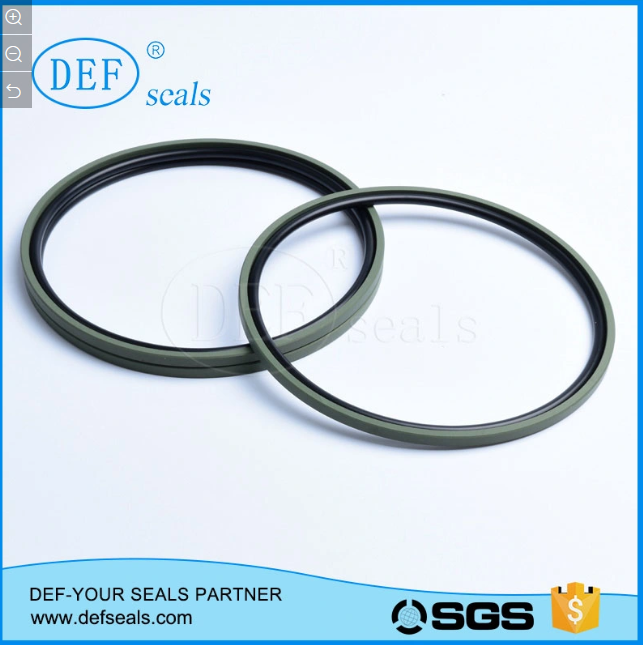Selection and installation of sealing gasket materials
2023-04-18
The selection of gasket material mainly depends on the following three factors: temperature, pressure, and medium.
1、 Metal gasket material
1. Carbon steel:
It is recommended that the working temperature should not exceed 538 ℃, especially when the medium has oxidizing properties. High quality thin carbon steel plates are not suitable for equipment manufacturing inorganic acid, neutral or acidic salt solutions. If carbon steel is subjected to stress, the equipment accident rate under hot water conditions is very high. Carbon steel gaskets are typically used for high concentrations of acids and many alkaline solutions. Brinell hardness is about 120.
2. 304 stainless steel
18-8 (chromium 18-20%, nickel 8-10%), recommended operating temperature not exceeding 760 ℃. Within the temperature range of -196-538 ℃, stress corrosion and grain boundary corrosion are prone to occur. Brinell hardness hardness 160.
3. 304L stainless steel
The carbon content shall not exceed 0. 03%。 The recommended working temperature should not exceed 760 ℃. The corrosion resistance is similar to 304 stainless steel. The low carbon content reduces the precipitation of carbon from the lattice, and the resistance to grain boundary corrosion is higher than that of 304 stainless steel. Brinell hardness is about 140.
4. 316 stainless steel
18-12 (chromium 18%, nickel 12%), adding about 2% molybdenum in 304 stainless steel, increases its strength and corrosion resistance as the temperature increases. When the temperature increases, it has higher creep resistance than other ordinary stainless steels. The recommended working temperature should not exceed 760 ℃. Brinell hardness is about 160.
5. 316L stainless steel
It is recommended that the continuous working temperature should not exceed 760 ℃~815 ℃. Compared to 316 stainless steel, it has better resistance to stress and grain boundary corrosion when the carbon content does not exceed. Brinell hardness is about 140.
6. 20 alloy
45% iron, 24% nickel, 20% chromium, and a small amount of molybdenum and copper. The recommended working temperature should not exceed 760 ℃~815 ℃. Especially suitable for manufacturing equipment resistant to sulfuric acid corrosion, with Brinell hardness hardness of about 160.
7. Aluminum
Aluminum (content not less than 99%). Aluminum has excellent corrosion resistance and processing performance, making it suitable for manufacturing double clip gaskets. Brinell hardness is about 35. It is recommended that the continuous working temperature should not exceed 426 ℃.
8. Purple copper
The composition of red copper is close to that of pure copper, and it contains trace amounts of silver to increase its continuous working temperature. It is recommended that the continuous working temperature should not exceed 260 ℃. Brinell hardness is about 80.
9. Brass
(Copper 66%, Zinc 34%) has good corrosion resistance under most operating conditions, but is not suitable for acetic acid, ammonia, salt, and acetylene. It is recommended that the continuous working temperature should not exceed 260 ℃. Brinell hardness is about 58.
10. Hastelloy B-2
(26-30% molybdenum, 62% nickel, and 4-6% iron). The recommended working temperature should not exceed 1093 ℃. Has excellent heat-resistant concentration hydrochloric acid corrosion performance. It also has excellent resistance to wet hydrogen chloride gas corrosion, sulfuric acid, phosphoric acid, and reducing salt solution corrosion. High strength under high temperature conditions. Brinell hardness is about 230.
11. Hastelloy C-276
16-18% molybdenum, 13-17.5% chromium, 3.7-5.3% tungsten, 4.5-7% iron, and the rest are all nickel). The recommended working temperature should not exceed 1093 ℃. Has excellent corrosion resistance. For various attempts of cold nitric acid or boiling nitric acid with a concentration of 70%, it has excellent corrosion resistance, good resistance to hydrochloric acid and sulfuric acid corrosion, and excellent stress corrosion resistance. Brinell hardness is about 210.
12. Inconel 600
Nickel based alloys (77% nickel, 15% chromium, and 7% iron). The recommended working temperature should not exceed 1093 ℃. It has high strength under high temperature conditions and is usually used for equipment that needs to solve stress corrosion problems. Under low temperature conditions, it has excellent co processing performance. Brinell hardness is about 150.
13. Monel 400
(It is recommended that the continuous working temperature of copper 30% and nickel should not exceed 815 ℃. Except for strong oxidizing acids, it has excellent corrosion resistance to most acids and alkalis. It is easy to produce stress corrosion cracks in fluoric acid, mercuric chloride and mercury media, so it is not suitable for the above media. It is widely used for equipment manufacturing hydrofluoric acid. The Brinell hardness is about 120
14. Titanium
The recommended working temperature should not exceed 1093 ℃. Under high temperature conditions, it has excellent corrosion resistance. It is well known that it is resistant to chloride ion corrosion and has excellent resistance to nitric acid corrosion over a wide temperature and concentration range. Titanium is rarely used in most alkaline solutions and is suitable for oxidation conditions. Brinell hardness is about 216.
2、 Non metallic gasket material
1. Natural rubber NR
It has good corrosion resistance to weak acids and bases, salt and chloride solutions, but poor corrosion resistance to oil and solvents, and is not recommended for use in ozone media. Recommended working temperature -57 ℃~93 ℃.
2. Neoprene rubber CR
Neoprene rubber is a synthetic rubber that is suitable for corrosion resistance in moderately corrosive acid, alkali, and salt solutions. It has good corrosion resistance to commercial oils and fuels. However, in highly oxidizing acids, aromatic hydrocarbons, and chlorinated hydrocarbons, their corrosion resistance is poor. Recommended working temperature -51 ℃~121 ℃.
3. Nitride rubber NBR
Cyanobutadiene rubber is a synthetic rubber that is suitable for having good corrosion resistance to oil, solvents, aromatic hydrocarbons, alkaline hydrocarbons, petroleum, and natural gas over a wide temperature range. It has good corrosion resistance to hydroxides, salts, and nearly neutral acids. However, in highly oxidizing media, chlorinated hydrocarbons, ketones, and lipids, their corrosion resistance is poor, and the recommended working temperature is 51 ℃~121 ℃.
4. Fluororubber
It has good corrosion resistance to oils, fuels, chloride solutions, aromatic and lipid hydrocarbons, and strong acids, but is not suitable for use in amines, lipids, ketones, and vapors. The recommended working temperature is -40 ℃~232 ℃.
5. Chlorosulfonated polyethylene synthetic rubber has good corrosion resistance to acid, alkali, and salt solutions, while being unaffected by climate, light, ozone, and commercial fuels such as diesel and kerosene. But it is not suitable for use in aromatic hydrocarbons, chlorinated hydrocarbons, chromic acid, and nitric acid. Recommended working temperature -45 ℃~135 ℃.
6. Silicone rubber
Good corrosion resistance to hot air. Silicone rubber is not affected by sunlight and ozone. But it is not suitable for use in steam, ketones, aromatic hydrocarbons, and lipid hydrocarbons.
7. Ethylene propylene rubber
It has good corrosion resistance to strong acid, alkali, salt, and chloride solutions. But it is not suitable for use in oils, solvents, aromatic hydrocarbons, and hydrocarbons. Recommended working temperature -57 ℃~176 ℃.
8. Graphite
All graphite materials without resin or inorganic compound can be divided into metal doped or non metal doped graphite materials. This material can be bonded to manufacture gaskets for pipes with diameters exceeding 600MM. It has excellent corrosion resistance to many acids, bases, salts, organic compounds, heat transfer solutions, and even high-temperature solutions. It cannot melt, but will sublimate when it exceeds 3316 ℃. Under high temperature conditions, caution should be exercised when using this material in highly oxidizing media. In addition to being used for gaskets, this material can also be used to make non-metallic winding tapes in fillers and spiral wound gaskets.
9. Ceramic fiber and ceramic fiber formed into strips are excellent gasket materials suitable for high temperature and low pressure conditions, as well as light flange conditions. The recommended working temperature is 1093 ℃, and they can be used to make non-metallic winding strips in spiral wound gaskets.
10. PTFE combines the advantages of most plastic gasket materials, including temperature resistance ranging from -95 ℃ to 232 ℃. In addition to free fluorine and alkali metals, it has excellent corrosion resistance to chemicals, solvents, hydroxides, and acids. PTFE material can be filled with glass, with the aim of reducing the cold fluidity and creep of PTFE.
11. Other special sealing materials include fluorosilicone rubber, tetrapropylene fluororubber, hydrogenated nitrile rubber, phenyl silicone rubber, polyetheretherketone, polyimide, polyphenylene sulfide and other special rubber and plastic sealing materials.
Next —
News







